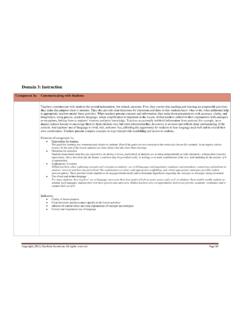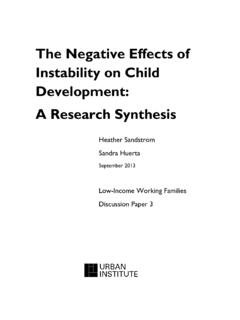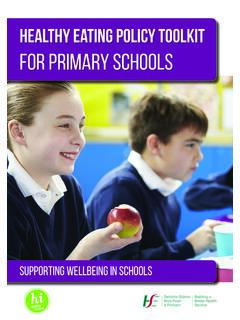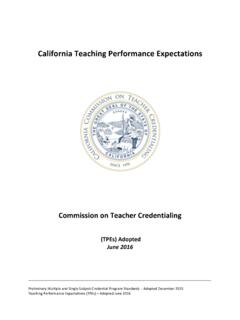Transcription of Domain 2: The Classroom Environment
1 Copyright, 2012, Charlotte Danielson. All rights reserved Page 16 Domain 2: The Classroom Environment Component 2a: creating an Environment of Respect and Rapport An essential skill of teaching is that of managing relationships with students and ensuring that relationships among students are positive and supportive. Teachers create an Environment of respect and rapport in their classrooms by the ways they interact with students and by the interactions they encourage and cultivate among students. An important aspect of respect and rapport relates to how the teacher responds to students and how students are permitted to treat one another. Patterns of interactions are critical to the overall tone of the class.
2 In a respectful Environment , all students feel valued, safe, and comfortable taking intellectual risks. They do not fear put-downs or ridicule from either the teacher or other students. Respect shown to the teacher by students should be distinguished from students complying with standards of conduct and behavior. Caring interactions among teachers and students are the hallmark of component 2a ( creating an Environment of respect and rapport); while adherence to the established Classroom rules characterizes success in component 2d (Managing student behavior). Elements of component 2a: Teacher interactions with students, including both words and actions A teacher s interactions with students set the tone for the Classroom .
3 Through their interactions, teachers convey that they are interested in and care about their students. Student interactions with other students, including both words and actions As important as a teacher s treatment of students is, how students are treated by their classmates is arguably even more important to students. At its worst, poor treatment causes students to feel rejected by their peers. At its best, positive interactions among students are mutually supportive and create an emotionally healthy school Environment . Teachers not only model and teach students how to engage in respectful interactions with one another but also acknowledge such interactions. Indicators: Respectful talk, active listening, and turn taking Acknowledgement of students background and lives outside the Classroom Body language indicative of warmth and caring shown by teacher and students Physical proximity Politeness and encouragement Fairness Copyright, 2012, Charlotte Danielson.
4 All rights reserved Page 17 Unsatisfactory Basic Proficient Distinguished 2a: creating an Environment of Respect and Rapport Patterns of Classroom interactions, both between teacher and students and among students, are mostly negative, inappropriate, or insensitive to students ages, cultural backgrounds, and developmental levels. Student interactions are characterized by sarcasm, put-downs, or conflict. Teacher does not deal with disrespectful behavior. Patterns of Classroom interactions, both between teacher and students and among students, are generally appropriate but may reflect occasional inconsistencies, favoritism, and disregard for students ages, cultures, and developmental levels.
5 Students rarely demonstrate disrespect for one another. Teacher attempts to respond to disrespectful behavior, with uneven results. The net result of the interactions is neutral, conveying neither warmth nor conflict. Teacher-student interactions are friendly and demonstrate general caring and respect. Such interactions are appropriate to the ages, cultures, and developmental levels of the students. Interactions among students are generally polite and respectful, and students exhibit respect for teacher. Teacher responds successfully to disrespectful behavior among students. The net result of the interactions is polite, respectful, and businesslike, though students may be somewhat cautious about taking intellectual risks.
6 Classroom interactions between teacher and students and among students are highly respectful, reflecting genuine warmth and caring and sensitivity to students as individuals. Students exhibit respect for teacher and contribute to high levels of civility among all members of the class. The net result is an Environment where all students feel valued and are comfortable taking intellectual risks. Critical Attributes Teacher is disrespectful towards students or insensitive to students ages, cultural backgrounds, and developmental levels. Students body language indicates feelings of hurt, discomfort, or insecurity. Teacher displays no familiarity with, or caring about, individual students.
7 Teacher disregards disrespectful interactions among students. The quality of interactions between teacher and students, or among students, is uneven, with occasional disrespect or insensitivity. Teacher attempts to respond to disrespectful behavior among students, with uneven results. Teacher attempts to make connections with individual students, but student reactions indicate that these attempts are not entirely successful. Talk between teacher and students and among students is uniformly respectful. Teacher successfully responds to disrespectful behavior among students. Students participate willingly, but may be somewhat hesitant to offer their ideas in front of classmates.
8 Teacher makes general connections with individual students. Students exhibit respect for teacher. Teacher demonstrates knowledge and caring about individual students lives beyond the class and school. There is no disrespectful behavior among students. When necessary, students respectfully correct one another in their conduct towards classmates. Students participate without fear of put-downs or ridicule from either the teacher or other students. Teacher respects and encourages students efforts. Possible Examples 2a The teacher does not communicate expectations for respectful behavior. The teacher ignores or does not intervene in disrespectful interactions. The teacher responds to students in a disrespectful manner.
9 For example, when students are talking out of turn during circle time, the teacher either ignores the misbehavior or yells at the students to Be quiet! Tommy drops his tub of paint on the floor. Some of the students begin to make fun of Tommy for being clumsy. Teacher ignores the behavior, or Teacher gets angry with him and says, Can t you be more careful? You do this all the time! The teacher responds inconsistently to disrespectful behavior. She communicates some positive Classroom expectations but does not model an alternative approach to disrespectful student behaviors. For example, when students are talking out of turn, Teacher says, please be quiet or we ll have to stop the activity.
10 But when the students don t stop, there s no follow through. After Tommy drops his tub of paint, some students make fun of him. Teacher says, Please, use kind words, but teacher does not provide an example of what kind words the students should use such as I m sorry, Tommy. Can I help you clean it up? Or, teacher tells Tommy to go get a towel and clean it The teacher often models and reminds students of Classroom expectations in a warm manner. For example, Remember to listen to Kathy s words or Thank you for helping Derrick when he was upset. After Tommy drops his paint, Tommy gets upset by crying and acting frustrated. Teacher reminds Tommy to use the words he has been taught when he is angry.










